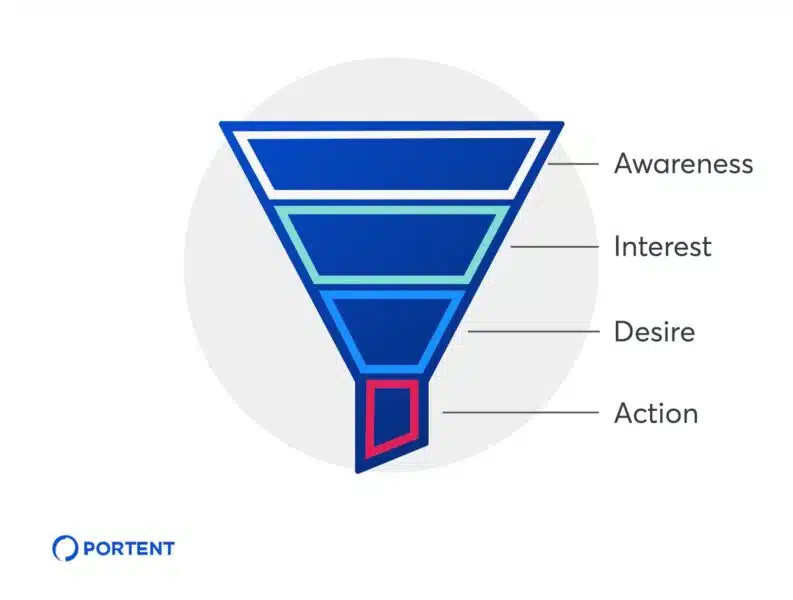To scale your PPC efforts and reach a broader audience effectively, you need a strategy encompassing every stage of the customer journey, from brand discovery to taking action.
This is where the concept of a full-funnel PPC approach comes into play.
This article will explain the importance of full-funnel PPC marketing and provide a solution for effective reporting with Looker Studio.
Discover how this strategy can impact your business and streamline your marketing efforts for long-term growth.
What is a full-funnel PPC strategy?
A full-funnel PPC strategy involves looking at all stages in your sales cycle and targeting users via PPC before they know your brand name or may know what solution or product they are looking for.
It helps you target prospects at multiple touchpoints from the Awareness stage all the way to the bottom of the funnel or Action stage.
Potential new customers at the Awareness stage will learn about your brand while seeking answers to their questions.

In many cases, paid search advertisers tend to get too focused on bottom-funnel lead acquisition, whether for lead generation or ecommerce.
However, understanding the importance of a full-funnel strategy can significantly benefit your business.
Dig deeper: How to use always-on marketing in paid search
The importance of a full-funnel strategy in PPC
Investing in a full-funnel strategy is well worth the effort. Let’s consider Portent’s own data from a full-funnel approach implemented for a B2B solution targeting mid-sized companies.
These campaigns, which embraced a full-funnel strategy, outperformed the previous campaigns that solely targeted bottom-funnel calls to action in acquiring new users and generating leads.
This data underscores the advantages of a full-funnel approach in reaching a broader audience and driving results.

Get the daily newsletter search marketers rely on.
PPC campaigns by funnel stages
Now that we see the impact, what campaigns fall under each stage?
Generally, for top-of-funnel awareness campaigns, the best campaign types are:
For middle-of-funnel campaigns, we often classify:
- Non-branded Search campaigns.
- Display and Video and Demand Gen campaigns.
- Remarketing.
For bottom-of-funnel or action campaigns, we would consider:
- High-intent keyword Search campaigns.
- Brand Search campaigns.
- Performance Max.
- Remarketing campaigns.
Difficulties reporting with Google Ads data
One of the biggest challenges when convincing your boss or client to invest in a full-funnel strategy is providing the data to track performance once the campaigns are live.
For Awareness or top-of-funnel campaigns, you want to evaluate their performance on:
- Impressions.
- View-through rate.
For the Interest or Desire stage, you want to look at engaged sessions or other engagement metrics such as:
- Engagement rate.
- Time spent on page.
- Clicks on certain page elements.
Finally, for the Action section of the account, you will want to track your primary conversions, such as:
The question is, how does all of this get reported and visualized?
The top and middle funnel KPIs are only available in Analytics, whereas the KPIs of the funnel’s Action section are metrics you would track in Google Ads.
The answer is to use Looker Studio to create full-funnel reports.
Full-funnel PPC reporting with Looker Studio
When using Looker Studio, you must guide the visitor through your full-funnel strategy with visuals illustrating what your funnel looks like.
By breaking down the stages in each slide, you can direct the reader to focus on the appropriate metrics for that stage rather than solely concentrating on the bottom-of-funnel action conversions, such as purchases or form fills.
For example, in your report, you can start at the top of the funnel, including metrics relevant to that stage.
It’s advisable to include cost data for various campaign types (e.g., Display, Video, Demand Gen) month over month (MOM). This approach allows for a more focused and clear presentation of data.
Another idea to improve this slide for a client is to include a table with the breakdown of top-of-funnel campaigns. We also recommend providing images or videos on the slide so the user understands which ads are Awareness.

The benefit of this strategy is breaking out the stages in each slide allows you to direct the reader to focus on the appropriate metrics for that stage and not focus solely on the bottom-of-funnel action conversions such as purchases or form fills.
I recommend having a separate slide for each funnel stage rather than combining all full-funnel metrics into a single slide.
The combination of data can be overwhelming and may confuse the visitor about which metrics are the most important.
By presenting each stage individually, you can provide a clear and concise view of the performance at each funnel level.
Dig deeper: 5 things your Google Looker Studio PPC Dashboard must have
Full-funnel reporting simplified
Once you have created your full-funnel report using Looker Studio, you can analyze the impact of your investment in top-of-funnel campaigns on your overall primary conversion actions. This analysis can be done quarterly or over longer time frames.
While it’s important to note that the benefits of top-of-funnel campaigns may take longer to materialize compared to bottom-of-funnel strategies, educating your boss or client on the importance of a full-funnel approach can lead to larger year-over-year growth.
A full-funnel strategy is a valuable approach for targeting prospects at various stages of the customer journey. To effectively report on the performance of such campaigns, Looker Studio can be a powerful tool, providing the necessary data visualization and reporting capabilities.
By breaking down the metrics and guiding the reader through each stage of the funnel, you can ensure that your reporting is clear, focused, and insightful.
Over time, the data collected from top-of-funnel campaigns can provide valuable insights into their impact on your overall business goals.
Opinions expressed in this article are those of the guest author and not necessarily Search Engine Land. Staff authors are listed here.
Source link : Searchengineland.com
